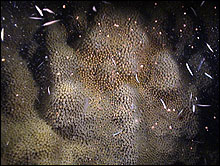Archives
"Sex on the reef" ritual attracts UB biologists seeking genomic clues to coral bleaching
By ELLEN GOLDBAUM
Contributing Editor
The one-night-a-year spawning of massive star corals (Montastraea species) off the Florida coast generates millions of infant corals, each of which has the potential to help replenish coral reefs that have undergone significant environmental damage in recent years.

This photo shows bundles of eggs and sperm released during last year's spawning of massive star corals (Montastraea species) off the Florida coast. This one-night-a-year spawning generates millions of infant corals.
PHOTO: ALINA SZMANT
Even so, the chance that these bundles of eggs and sperm released in early September will result in healthy new individuals capable of replenishing reefs depends on many factors, most importantly the establishment of symbiosis between corals and the algal symbionts that live in, and nourish, them.
That's why Mary Alice Coffroth, associate professor in the Department of Biological Sciences in the College of Arts and Sciences, and her technician, Cynthia Lewis, will travel early this month to the Florida Keys, where a team of scientists will be night-diving right alongside the millions of teeming egg-sperm bundles released from corals off the coast of Key Largo.
They will be obtaining samples as part of the first effort to use genomic methods to discover how symbiosis is established in hard corals.
"Little is known about the molecular basis for establishing and maintaining these common biological relationships, which play a key role in the formation of coral reefs," said Coffroth.
Corals survive and thrive, Coffroth explained, because of the symbiotic relationship they develop with the single-celled algae called zooxanthellae (zo-zan-thel-y) that live inside them and help supply them with food.
Coral bleaching, a loss of these algal symbionts, can result from environmental changes, such as elevated levels of sunlight and elevated seawater temperatures that interfere with these relationships, reducing algal densities in corals.
"Ultimately, we want to understand why the symbiosis breaks down, causing corals to bleach," said Coffroth, who is working with other biologists and genome scientists from the University of North Carolina at Wilmington, the U.S. Department of Energy's Joint Genome Institute in Walnut Creek, Calif., and the California Academy of Sciences.
The idea behind the team's research is to try to understand the mechanisms that determine how symbiosis is established by identifying candidate genes that control recognition between the corals and their algal symbionts.
"I want to know, 'Do these corals take up just one type of algal symbiont or many?' and 'Is the final selection genetically or environmentally determined?'" said Coffroth. "Is it that a particular algae turns on specific genes in the coral and others don't?"
Coffroth and her colleagues will be collecting thousands of egg-sperm bundles, fertilizing them in a laboratory at UB and rearing them as developing embryos.
To identify genes that are involved in the establishment of the symbiosis, they will sample the developing larvae with and without algal symbionts over time.
The zooxanthellae used to establish these symbioses were isolated by Coffroth and are part of an extensive culture collection maintained in Coffroth's lab.
"We are very lucky to have the facilities in the Department of Biological Sciences at UB to house this collection," said Coffroth. "It is one of the largest of its kind in the world."
Most of the samples will be sent to the Joint Genome Institute in California, where genomics scientists will screen them to identify genes that are being expressed during the establishment of the symbiosis.
Some of the newly settled coral larvae will be placed back on the reef where the establishment of the symbiosis and survival of these new recruits will be monitored over time.
"A better understanding of host-symbiont relationships in coral-reef ecosystems can have implications for atmospheric and ocean sciences, conservation biology and the study and diagnosis of microbial diseases in corals," said Coffroth.
